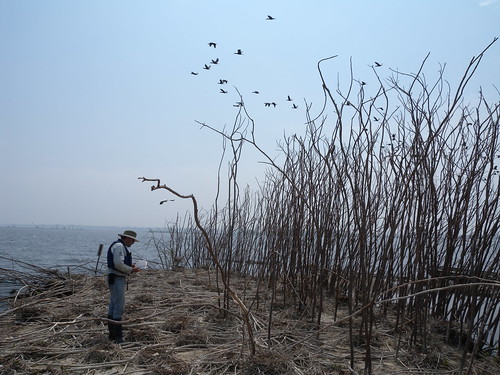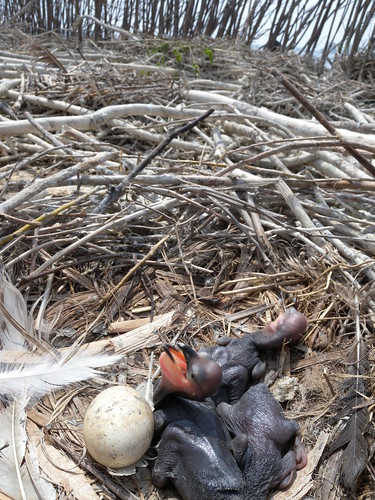 |
| Sumner Mattson (WDNR) counts doiuble-crested cormorant nests, while adults fly overhead. |
I remember wildlife specials on TV from of Florida and other tropical places, where slender white birds with long plumes perched in flimsy nests. There were strange looking black birds, and others had white long bills and yellow pouches they dipped in the water to scoop up fish. Now those far places are here, they are on the islands of our lakes, and even within our cities. It isn’t some new strange phenomenon, but the return of fish-eating birds after the banning of DDT and unregulated hunting. Pelicans are experiencing a natural expansion of their range, and may have been present here pre-settlement. These water birds are back and in some areas more numerous than they were 200 years ago, so it is a good idea to keep tabs on them. With current staff there are too many sites to survey, but the Wisconsin Department of Natural Resources surveys some. I helped with a survey on May 12, 2011 on Lake Butte des Morts.
 |
| American white pelican on Lake Butte des Morts, Winnebago County nest made of gravel. |
The nesting colonies are truly fascinating places. I saw all those “Florida birds” from TV: white pelicans, double-crested cormorants, great egrets, black-crowned night herons, great-blue herons, and cattle egrets. I walked among hundreds of nests, thousands of eggs, and was surrounded by birds taller than my seven year-old anxiously waiting for me to leave. There is a certain awe being surrounded by so much life, so many eggs about to hatch, in such a foreign landscape. However, most sane people would stay far from here. Our nesting colonies are like those anywhere else that seabirds have nested for tens of millions of years, and there is much that makes all nesting colonies unpleasant. American White Pelicans are very large and weigh about 16 lbs. and their big feet trample everything. They even flatten cattails to make an area suitable for nesting. Then there is the obvious: a few thousand birds defecating in the same place day after day along with rotting fish and birds, producing an awful stench and polluting the surrounding water. Many of these birds nest in trees, but eventually they produce so much nutrient-rich guano that they kill all the vegetation on these islands including the trees they nest in. After spending several hours the fetid air began to make me weak and I could start to feel a burning sensation in my lungs.
 |
| Cormorant chicks and eggs |
It paints a nasty scene, both beautiful and revolting, but that’s nature. Our lakes are as pretty as a postcard and the mosquitoes are as ruthless as the Russian mafia. I don’t know how many cormorants or pelicans are too many, but it seems we have enough. I don’t want too many of our islands, points and secluded areas to be polluted by species that congregate in numbers too many and produce so much pollution that they destroy their own habitat. Species just like the one with the clipboard counting the nests.
Nesting Colony
Subscribe to my YouTube Channel
No comments:
Post a Comment